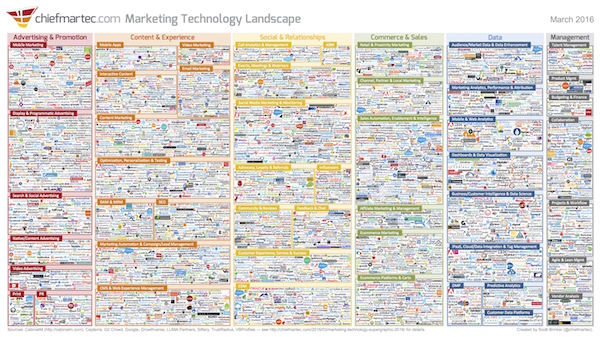Q: How many technology vendors does it take to screw in a lightbulb?
A: Depends, what’s your budget?
Technology buyers have changed, and so has the buying process. According to recent research, if you’re a baby boomer, you’re likely to rely heavily on industry analysts for advice in the early stages of the decision. If you’re a Gen X decision-maker who’s about to pull the trigger, you prefer live or in-person demos.
But you may not even realize the generational or experiential biases you are bringing to your purchase decision. You’ve probably formed habits that may or may not be helping you make an effective technology choice.
And you have a LOT of choices. Not to freak you out, but this graphic is just for marketing technology.
Become a better technology buyer
Over the last 20 years, I have talked with hundreds of technology buyers in various stages of the decision process.
One scenario that comes up often is the disconnect between the person who will ultimately use the technology and the person who is procuring it. The most effective organizations put those two people (or teams) in the same room and lock the door, not letting them out until they understand thoroughly what will be purchased.
Another frequent issue is “champagne dreams on a beer budget.” If you’re a buyer on a strict budget, assume that you’re going to need to triage the feature set you’re getting. Figure out what’s a must-have and what’s a nice-to-have, so you can live without paying for expensive customizations.
Don’t start Googling technology vendors until you know your business goals, your budget, and your timeline.
How to buy technology efficiently
- Start at the beginning. What business challenge are you trying to solve, what business goal are you looking to achieve? How is your own success measured? If you have answers to those questions, it will be pretty obvious whether a particular technology can help you or not.
- Nail down your budget and resources. If you don’t have either of those things, you shouldn’t waste time getting software demos. (Dude, that’s boring anyway.) Knowing how much you can spend, over what period of time, will help you know if you should visit the Ferrari dealership or look at the used cars on Craigs List.
- Let the mission drive your feature set, not the other way around. Design mockups and super-detailed feature requirements are fun to brainstorm, but don’t let them drive the whole process. You may discover new ways of achieving your goals if you allow the technology vendor to share their expertise. They are probably talking to others in your niche all day long, trying to solve the same problems, and they may have a fresh take on things. There may be features you didn’t even dream up. If you need to provide a pixel-detailed mockup, expect to make a significant investment.
- Know the process. For larger technology purchases, you may need to have legal resources to review the agreement you’ll be signing (particularly if it’s software-as-a-service, where you’re accessing a platform from your browser). Make sure that you have buy-in and participation from anyone on your team who needs to sign off on the purchase.
- Establish a timeline. When do you want to start actually using the technology? Will it be available? Do you need training before it’s released into the wild?
It’s easy to see technology vendors as adversaries in the sales process…after all, they want your money, right? However, the good vendors also want to build a strong partnership with you so that you can work together over the long haul. Look for sales teams who treat the purchasing process as a partnership and give you sound advice along the way. That’s probably a good clue as to how you’ll be treated as a customer, too.
What are your lessons-learned for buying technology?
Author’s Bio: Rosemary O’Neill is an insightful spirit who works for Social Strata — makers of the Hoop.la community platform. Check out the Social Strata blog. You can find Rosemary on Google+ and on Twitter as @rhogroupee
